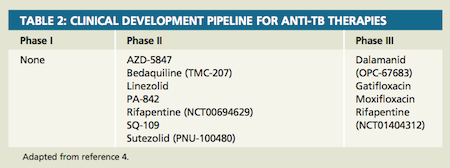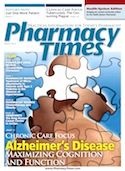Publication
Article
Pharmacy Practice in Focus: Health Systems
Tuberculosis: The Consuming Plague
Author(s):
The development of multidrug-resistant and extensively drug-resistant tuberculosis in recent decades has made treatment challenging.
As early as 400 BCE, Hippocrates had well described phthisis—or “consumption”—as a mortal illness involving fever and the coughing up of blood.1 Yet it was not until the fully developed body of work contributed by Robert Koch in the late 19th century (for which he was awarded the Nobel Prize in 1905) that we truly understood tuberculosis (TB) as an infectious disease caused by a singular bacterial pathogen. Catalyzed by the less than sanitary living conditions in England and Europe at the time, case rates have been estimated as high as 1000 cases per 100,000 persons, and mortality from TB-related death may have accounted for as many as 25% of deaths.2
Despite widespread disease, effective drug therapy for TB did not exist until the discovery of streptomycin in 1943. Many patients were cured with streptomycin in what are believed to be some of the first “modern” clinical trials. Yet many relapsed and displayed the evolution of resistance to streptomycin. In the 20 years that followed, we saw the development of the typical drugs we use currently to treat TB, as well as the evolution of the multidrug regimens we still use today.2,3 Despite these advances and improvements in public health and sanitation, TB remains a problem globally.
One of the most challenging aspects of the contemporary management of TB has proved to be the continued development of drug resistance in Mycobacterium tuberculosis and the evolution of both multidrug-resistant (MDR) and extensively drug-resistant (XDR) TB over the past 20 years. In this environment, the FDA’s recent approval of Sirturo (bedaquiline, formerly TMC207) is poised to play a significant role in the management of drug-resistant TB.

The State of Things
The global burden of TB is enormous. It is estimated that up to one-third of the world’s population has been exposed to TB. The most current data from the World Health Organization (WHO) estimate that worldwide in 2011 some 8.7 million individuals fell ill with TB (incident cases; rate = 125 cases per 100,000 persons), an estimated 12 million were infected (disease prevalence), and 1.4 million died from TB-related causes. Although these rates are, in fact, declining (down 2.2% from 2010) and have been for some years, the global burden of disease is comparably massive; TB is the second-leading cause of death from a single infectious agent worldwide (behind HIV/AIDS).4
The story is somewhat more tame in the United States and in most developed, wealthy countries. The Centers for Disease Control and Prevention (CDC) reports that in 2011 there were 10,528 incident cases of TB in the United States (rate = 3.4 per 100,000), representing a 5.8% decrease from 2010.5
Although the incidence and prevalence of TB is declining globally, due in no small part to the work of agencies like the CDC and WHO, some statistics are not as comforting. The percentage of new cases of TB that are MDR continues to increase annually. In the United States, the proportion of new cases of TB that are MDR has increased from 0.9% in 2008 to 1.3% in 2011.5 Globally it is estimated that 3.7% of new cases of TB were MDR in 2011. Yet in high-incidence countries like Belarus, Kazakhstan, and the Russian Federation, these estimates have soared to as high as 32%, 30%, and 20%, respectively. In terms of the global burden of MDR TB disease, the top 5 countries according to overall disease prevalence are (in order): India, China, the Russian Federation, South Africa, andBangladesh. Collectively, India and China account for 50% of the global burden of MDR TB.4
Treatment
The therapy of TB has changed little since the 1980s. The 1970s and 1980s saw the development of the combination therapy regimens we still use today. It was discovered early on after the introduction of streptomycin that single-drug therapy for TB frequently leads to the development of drug resistance rather than cure. Out of the following decades of drug discovery and clinical study, the multidrug regimens we use today emerged, consisting of rifampin (RIF), isoniazid (INH), pyrazinamide (PZA), and ethambutol (EMB).
Primary therapy for a new incident case of TB in the modern era consists of a 6-month regimen of RIF-containing therapy. Typically, treatment is initiated with a 2-month combination of RIF/INH/ PZA/EMB (the constituents of the popular “R.I.P.E” acronym/mnemonic). This is referred to as the “intensive phase” of therapy. Assuming therapy goes well and sputum smears become negative, the intensive phase is followed by a 4-month “continuation phase” of RIF/INH or RIF/INH/EMB (in areas of known high levels of resistance to INH).2,3 The currently available agents for the treatment of TB are listed in Table 1.
Therapy of MDR TB is a different creature altogether. The WHO’s definition of MDR TB is disease caused by M. tuberculosis resistant to both RIF and INH. Similarly, XDR TB is disease that is resistant to RIF, INH, a fluoroquinolone, and an aminoglycoside (such as amikacin).4 As MDR TB is resistant to the RIF/INH backbone of typical therapy, treatment consists of a combination of drugs rarely seen in common pharmacy practice.
The WHO recommends treatment consisting of a 5-drug regimen of a fluoroquinolone (moxifloxacin is preferred), PZA, an aminoglycoside, ethionamide, and cycloserine. The CDC’s recommendation is a bit less exotic, consisting of a 4-drug regimen of a fluoroquinolone, PZA, EMB, and an aminoglycoside (“injectable agent” in the CDC’s terminology). In these scenarios, the intensive phase (that containing parenteral agents) should last at least 6 months, or 4 months after sputum smears have become negative. Duration of therapy should be a minimum of 18 months after negative sputum culture, typically approaching 24 months of treatment in total.4,5

On December 28, 2012, the FDA approved Sirturo (bedaquiline) as part of combination therapy for adults with pulmonary MDR TB. Bedaquiline is a first-in-class diarylquinoline antibiotic that acts by inhibiting the mycobacterial adenosine triphosphate synthase. It was given fast-track designation and priority review, and granted orphan status. Reviewed under the FDA’s accelerated approval program, bedaquiline's approval is based on interim surrogate end points from Phase II data that, in the FDA’s words, “are reasonably likely to predict clinical benefit to patients.”6
These surrogate end points for bedaquiline were the microbiologic outcomes of sputum culture conversion at 24 and 72 weeks after the initiation of therapy. Most impressively, the addition of bedaquiline to the first 24 weeks of TB therapy yielded sputum culture conversion (i.e., negative sputum cultures for M. tuberculosis) in 77.6% versus 57.6% of patients given placebo (P = .014).7
Confounding the development of novel agents for the treatment of TB are the cumbersome and extraordinarily lengthy treatment regimens that are necessary, especially to treat MDR TB. Final clinical outcomes (ie, cure and relapse rates) for bedaquiline will take 24 months (96 weeks) of drug therapy and potentially years of follow-up. Another agent in the pipeline is the nitroimidazole delamanid (OPC-67683), also active in vitro and in vivo against MDR TB. Beyond these novel agents, the specific contributions of the addition of fluoroquinolones such as moxifloxacin to a multi-drug TB regimen are currently under systematic investigation, as well as the outcomes of adding linezolid (which has proved to be quite active in vitro against many Mycobacterium species) to such regimens. Ultimately, prevention will likely play the greatest role in the global fight against TB. Vaccines are currently under investigation, but are likely far off on the horizon.3
Final Thought
Beyond novel therapeutics, advances in the diagnosis of TB are needed. Rapid molecular diagnostics as well as rapid drug-resistance detection using polymerase chain reaction—based technology will speed the time to diagnosis and appropriate treatment. Continued success in the global fight against HIV/ AIDS will also play no small role in the future of TB worldwide. Ultimately, success will require a multi-faceted approach and the full support of the developed world through organizations like the WHO.8 Approval of the first novel anti- TB drug in 50 years could mark the beginning of the end of the battle with this ancient foe.
William L. Musick, PharmD, BCPS (AQ-ID), is a clinical specialist in infectious diseases and director of the PGY2 Pharmacy Residency in Infectious Diseases at The Methodist Hospital in Houston, Texas.
References:
- Hippocrates. Aphorisms. Translated by Francis Adams. The Internet Classics Archive. http://classics.mit.edu//Hippocrates/aphorisms.html. Accessed Jan 14, 2013.
- Lawn SD, Zumla AI. Tuberculosis. Lancet. 2011;378(9785):57-72.
- Mitchison D, Davies G. The chemotherapy of tuberculosis: past, present and future. Int J Tuberc Lung Dis. 2012;16(6):724-732.
- Global tuberculosis report 2012. Geneva, Switzerland: World Health Organization; 2012.
- Reported Tuberculosis in the United States, 2011. Atlanta, GA: US Department of Health and Human Services, Centers for Disease Control and Prevention; October 2012.
- FDA press release [untitled]. www.fda.gov/NewsEvents/Newsroom/PressAnnouncements/ucm333695.htm. FDA; December 31, 2012. Accessed Jan 15, 2013.
- Sirturo (bedaquiline) [package insert]. Titusville, NJ: Janssen Therapeutics; December 2012.
- Keshavjee S, Farmer PE. Tuberculosis, drug resistance, and the history of modern medicine. N Engl J Med. 2012;367(10):931-936.
- World Health Organization. Guidelines for the programmatic management of drug-resistant tuberculosis - 2011 update. Geneva, Switzerland: World Health Organization; 2012.







